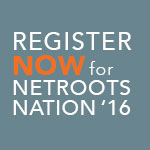After a great run, the Winning the Internet blog has been retired. However, you can still keep in touch with New Media Mentors here.

Luis Avila

Adria Marquez
As we get ready for Netroots Nation 2015, we’re taking a closer look at some of the convention’s most exciting training sessions. We’re interviewing the trainers and taking you inside some of online activism’s most popular and elusive topics.
Today we’re interviewing Adria Marquez of 270 Strategies, who’ll be leading ¡Se habla Español! Creating a Successful Bilingual Campaign, along with her colleague Luis Avila.
NN15 Training Session
¡Se habla Español! Creating a Successful Bilingual Campaign
All successful campaigns share some basic elements that help you win, but if you are running a bilingual campaign, there are important steps to take to help you engage Spanish-speakers more effectively. Latinos are one of the fastest growing demographics in the country, and campaigns are becoming bilingual from coast to coast. Join us to learn how to set up a successful bilingual campaign, learn about some case studies and ask questions, in English or Spanish!
Interview
Q: Tell us about yourselves and your experience developing bilingual campaigns.
A: Luis and I go way back. I was born in El Paso, Texas and raised in Ciudad Juarez, Mexico. Luis was born in Culiacán, Mexico and moved to Phoenix at the age of 18. Awesomely enough, our work together began as salsa-dancing partners at Arizona State University (Go Sundevils!), where we both attended as full time undergrad students. Little did we know, our paths would cross again eight years later in Portland, Oregon working for a national education advocacy organization.
With Luis heavily involved in state grassroots efforts and I, working with the national marketing & communications team, we both understood the value of organizing and effectively communicating with the Latino community. From our background and upbringing, we knew first hand that the Latino community is passionate about family and education, and we had a unique opportunity and important responsibility of prioritizing the needs of our community and providing resources to help educate, and empower Latino parents. Together, we worked on creating bilingual trainings, educational programs, prioritized bilingual digital outreach through websites and Spanish social media channels, and helped establish internal organizational processes for high quality messaging and translation.
Today, Luis and I still have the pleasure of working together as part of the 270 Strategies team under the grassroots and digital departments respectively. While our work with 270 isn’t exclusive to working on bilingual campaigns, cultural competence is a value that we try to instill every day with our colleagues and with the many organizations we have the fortune to work with.
Q: In your opinion, why don’t more people/organizations make their campaigns bilingual?
A: I believe it is often a combination of lack of available resources and understanding. Often times, we see campaigns and organizations approach translation as an afterthought, rather than integrating it as a strategic component to help meet organizational goals. Seeing that the Hispanic community is one of the fastest growing minority groups in the country, there are really no issues or conversations they should not be a part of. The Hispanic community cares about the very same issues the rest of the population cares about. We are passionate about education, we care for the environment, we care about the health and well-being of our loved ones, we believe in human rights, we want to be involved in local decision-making. We are a vital part of this community, and our involvement goes beyond translating a message, we have to be at the table.
Q: What are the two most important things to keep in mind when planning a bilingual campaign?
A: 1) Google Translate won’t cut it. 2) A bilingual campaign should speak to culture and values, not just language.
We can talk about do’s and don’ts all day long (and we may share some of our favorite examples), but at the end of the day we need to invest as much thought and resources into translation, messaging, copywriting, editing and proofreading in Spanish as much as we do for anything in English. Feeling overwhelmed? Here’s a pro-tip: recruit and hire bicultural, bilingual staff!
Q: Why should folks attend your session at Netroots Nation, and how can they connect with you?
A: We welcome anyone who wants to experience (if only for a couple of hours) and understand what it is like to be “lost in translation” through a dynamic bilingual presentation suited for anyone and everyone who is passionate about community empowerment and successful campaigns. We will share examples, best practices and respond to questions and challenges that we often face when planning bilingual campaigns.
I can be reached at @adriavmarquez and Luis (when not Salsa-dancing) can be found at @phoenikera. ¡Nos vemos en Julio!
To attend this training, or one of the 39 others at Netroots Nation 2015 in Phoenix, register now.




Comments are closed.